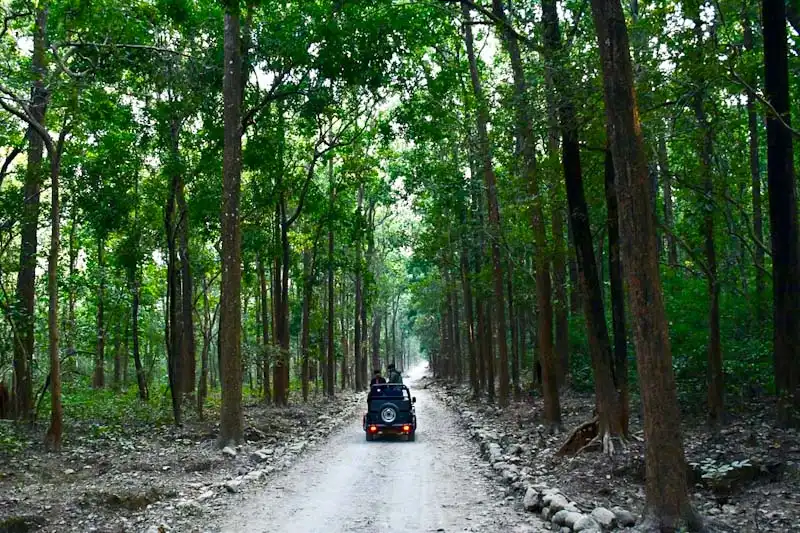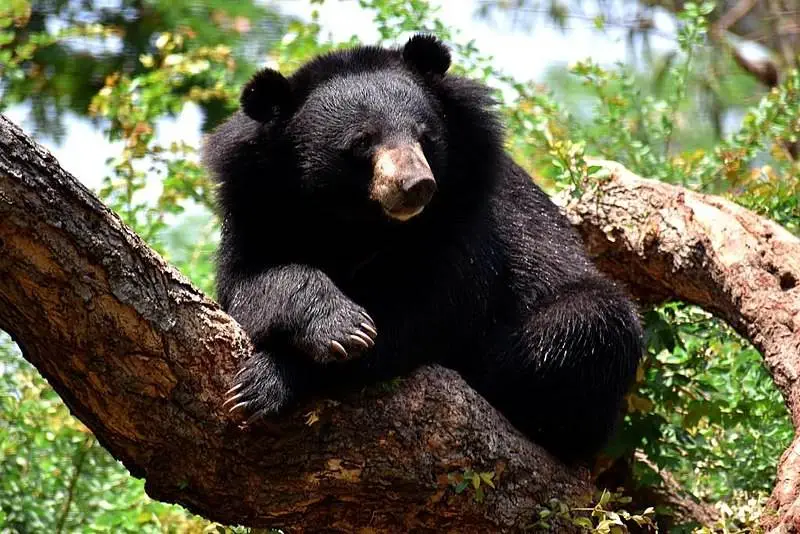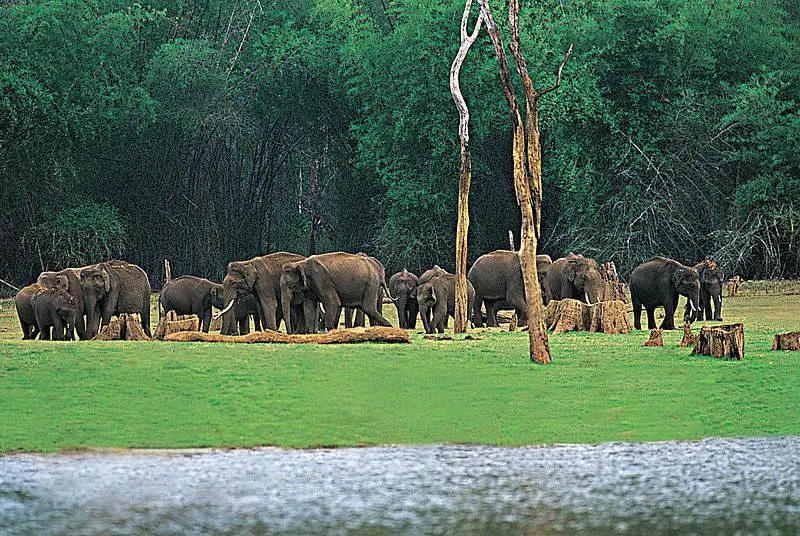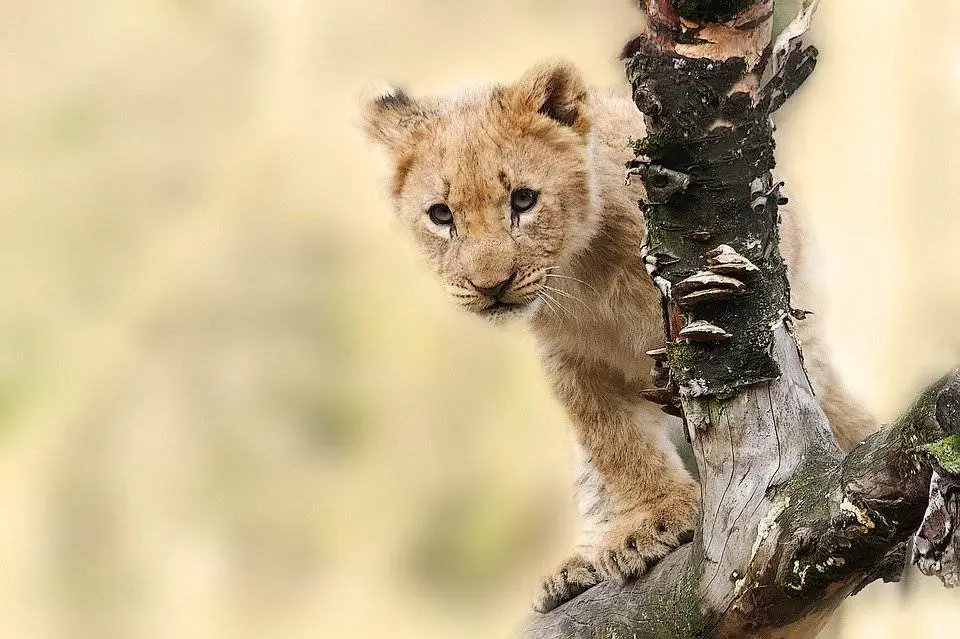Jungle safaris in India are very popular. There are about 99 national parks, 450 wildlife sanctuaries and 40 tiger reserves in India. Be it the mountains of Uttarakhand or deserts of Rajasthan, every nook of India embraces rich wildlife.
Our list of safaris in India allows everyone from the excited newbie to the committed animal lover to plan their next getaway into wild!
1. Bandhavgarh National Park, Madhya Pradesh

Bandhavgarh National Park is located in the Umaria district of Madhya Pradesh. This is one of the most popular safaris in India.
Known for: Spread over 1.5 square km, this park is home to sloth bear, leopards, barking deer, nilgai, python and of course, the Bengal tiger.
To emphasize, the park is known to have the World’s highest density of Bengal Tigers. The mix of tropical forest, Sal trees and grassland is home to score of bird species as well.
Best Time: November to March.
How to get there: Umaria district doesn’t have an airport facility. The nearest town is Jabalpur. There are taxi services, which ply from Jabalpur to Umaria.
Entry Gate/Safari Zone: Tala (Gate-1), Magadhi (Gate-2), Khitauli (Gate-3), Bandhavgarh Fort. The most popular zone is Tala Zone, the largest zone and with the most odds of spotting tigers.
2. Kanha National Park, Madhya Pradesh

Kanha National Park also known as Kanha Tiger Reserve is nestled in the Maikal range of Satpuras in Madhya Pradesh.
Known for: Kanha’s lush meadows provide sustenance to species including the barasingha (the only place it can be seen in the wild). Keep your eyes peeled for tigers, jackals and wild dogs and hyenas.
Best Time: November to April.
How to get there: The nearest airport/railway station to this Park is Jabalpur (160 km). There are many taxi service providers in Jabalpur.
Entry Gate/Safari Zone: The Park has 3 gates and 4 zones. Each gate is separated from the other by approximately 50-60 km. The three entry gates are “Khatia”, “Mukki” and “Sari” gate.
The most popular is the Khatia gate. The four zones are Kanha, Mukki, Kisli and Sarhi Zone. You can find more details of Kanha core zones here.
Always remember, when you book a safari, you book the same zone-wise and not gate-wise.
3. Panna National Park, Madhya Pradesh

With an area of 542 square km, this Park is located in Panna and Chhatarpur districts of Madhya Pradesh.
Known for: A popular tiger reserve is home to some of the rarest wildlife species. You will also see some frequent visitors such as sloth bear, wolves, languor, Chinkara and nilgai. The marine life inhabiting the Ken River includes gharial and mugger crocodiles.
Best Time: November to April.
How to get there: The nearest airport is Khajuraho (25 km). The nearest railway station is Jhansi (180 km) for people travelling from Mumbai, Delhi and Chennai.
Entry Gate/Safari Zone: There is one safari zone and two entry gates, being Hinauta and Madla. Madla is the prominent one with good accommodations nearby.
4. Pench National Park, Madhya Pradesh

This is the only national park that straddles across two states – the state of Madhya Pradesh and Maharashtra.
It is located in the southern border of Madhya Pradesh and the borders of Maharashtra. The park, consisting of an area of 758 square km, is a residence of a great variety of wildlife.
Known for: Tiger sightseeing at this park are a common thing. The place is abode to Bengal Tigers! You’ll find a good number of chital and migratory birds, making this reserve worth the visit.
Best Time: December to April.
How to get there: The nearest airport is Nagpur (132 km). The nearest railway station is Seoni (30 km).
Entry Gate/Safari Zone: This may sound daunting but this park has 11 safari gates (5 in Madhya Pradesh and 6 in Maharashtra). All gates are separated by 20-100 km.
5. Satpura National Park, Madhya Pradesh

Satpura National Park, also known as Satpura Tiger Reserve, is among the priceless gems of Madhya Pradesh. It is known to be one of the scenic Tiger reserves in India.
Located in the Hoshangabad district of Madhya Pradesh, its name is derived from the Satpura range. It covers an area of 524 square km.
Known for: Rich in diversity, commonly spotted are tigers, Indian Bison, leopard, sambar, chital, nilgai, chinkara, wild boar, sloth bear, Indian giant squirrel, blackbuck, flying fox, marsh crocodile. There is a huge variety of birds including lots of water birds and peacocks.
Best Time: March to June.
How to get there: The nearest airport is Bhopal (220 km) and Jabalpur (260 km). The nearest railway station is Sohagpur (18 km) and Hoshangabad (45 km).
Entry Gate/Safari Zone: The main entrance gate is Madhai. There are different zones – Lagadha, Jhinjhini Mehl, and Chutkidev. All these zones/routes originate from Madhai and jeep can be accordingly booked for the zone.
6. Jim Corbett National Park, Uttarakhand

The first park to adopt the Project Tiger initiative! This is the oldest national park in India, established in 1936 as Hailey National Park to protect the endangered Bengal Tiger.
Span over an extent of 520 square km, the Park comprises of hills, marshy depressions, grassland and riverine belt. It is among the few Tiger reserves in India that allow overnight stay in the lap of National Park.
Known for: In addition to Tigers, Corbett also provides shelter to the barking deer, Himalayan goral and yellow-throated martens among other animals.
Best Time: November to June.
How to get there: Jim Corbett is well connected to all major cities in India by train and road.
One of the most preferred ways to reach the Park is by road and the most convenient is from Delhi (245 km). The nearest railway station is Ramnagar (12 km).
Jim Corbett does not have an airport of its own and travellers usually not prefer travelling to the Park by air.
Entry Gate/Safari Zone: It is divided into 5 different zones. The more details about the Zones and Entry gates are here.
7. Binsar Wildlife Sanctuary, Uttarakhand

Situated in the foothills of Himalaya, this is a hidden gem in Almora district of Uttarakhand, offering one of the best wildlife safaris in India with a diverse range of birds and animals.
Known for: This is the Himalayan outpost for exotic flora and fauna, including the red fox, jackals and Himalayan black bears.
Best Time: February to April; and September to November.
How to get there: The nearest airport is Pantnagar (152 km from the city centre). Kathgodam is the nearest railway station to Binsar (119 km from the city centre).
Entry Gate/Safari Zone: Only one entry gate – Ayarpani.
8. Bandipur National Park & Tiger Reserve, Karnataka

This is regarded as one of the well-managed, and beautiful safaris in India. This park shares its boundary with other three other national parks. You’ll fall in love with its dense and lush green forest.
Known for: The one-time private hunting reserve for Maharajas of Mysore, Bandipur is a protected tiger reserve that houses elephants, Indian rock python, antelopes, sambar, spotted deer and other native species.
Best Time: November to June.
How to get there: The nearest airport is Mandakalli (Mysore). The nearest railway station is Mysore (80 km).
Entry Gate/Safari Zone: Melukammanahalli gate.
9. Nagarhole National Park & Tiger Reserve, Karnataka

This enchanting 247 square-mile long wild reserve is located in Kodagu and Mysore district of Karnataka. Also known as Rajiv Gandhi National Park, it is decked with rich forest cover at the West of the Kabini River.
Known for: A delight for lovers of Indian Tigers. Nagarhole’s ample bamboo cover is perfect for wild elephants. It houses The Indian wild dog, antelope and over 250 species of birds.
Best Time: November to May.
How to get there: The nearest airport is Mandakalli (Mysore) and is at a distance of 98 km. The nearest railway station is Mysore (80 km). Hire a taxi or take a bus to reach the Park.
Entry Gate/Safari Zone: The Park has three main entrance gates – Antharasanthe (near Kabini) on the eastern side towards Coorg, Nanachi (near Kutta) on the western side and Veeranahosahalli (near Hunsur) on the northern side.
10. Gir National Park, Gujarat

One of the most popular safaris in India, The Gir National Park or Sasan Gir is a wildlife sanctuary located in Junagadh, Gujarat.
Known for: Besides Africa, this Park is the only place in the world that houses (Asiatic) lions. It is also home to more than 40 species of reptiles and amphibians.
Best Time: Late November to Early March.
How to get there: The nearest airport is Keshod (70 km), Rajkot (160 km). The nearest railway station is Junagadh (80 km). Moreover, the Park is well connected to some of the major cities of Gujarat by a good road.
11. Velavadar National Park, Gujarat

Velvadar National Park was formerly the private grassland of the Maharaja of Bhavnagar. Spread over about 34 square km of area, a unique feature of the park is that it is the only tropical grassland in India to have the status of the national park.
Known for: This Park is home to the blackbuck. The other animals include nilgai, jackal, Indian grey wolf, and birds such as flamingoes, stork, etc. You’ll strain to see the animals through the tall, wild grass that camouflages them!
Best Time: December to March.
How to get there: The nearest airport is Bhavnagar (72 km). Ahmadabad airport is about 4-hour drive from the park. The nearest railway station is at the town of Dhola (50 km).
12. Hemis National Park, Ladakh (Jammu & Kashmir)

This high altitude national park in eastern Ladakh is nothing short of safari in heaven! With pine forest, lofty mountains and meadows, the park boast of its beauty for a reason!
Known for: Your best chance of spotting the elusive snow leopard! You can also spot the Asiatic Ibex, red fox, Tibetian wolf, Himalayan marmot.
Best Time: May to September.
How to get there: Leh is the base station to reach the park. Once at Leh, the park can be reached via road through a rental vehicle or bus, which plies daily from Leh to Hemis.
Entrance Gate: There are four entry points to the park – Martselang (to the south-east of the park, 41 km from Leh), Chillin (to the north-west, 60 km from Leh), Stok (to the north, 13 km from Leh), Zingchan (to the north, 25 km from Leh).
13. Kaziranga National Park, Assam

Located on the banks of river Brahmaputra, this safari is on everyone’s bucket list. The park covers two districts of Nagaon and Golaghat in Assam.
Known for: This UNESCO world heritage site is famed for one-horn rhino. It is home to about 2600 rhinos. Moreover, it is also home to breeding populations of tigers and leopards.
Best Time: November to April.
How to get there: There 2 nearest airports – Guwahati International Airport (217 km) and Jorhat Airport (97 Km). The nearest railway station is Furkating (75 km). The main entrance gate of the park is connected to all major cities by state-run buses and private buses.
Entry Gate/Safari Zone: The Park is divided into 4 tourism zones – Kaziranga zone (Central zone), Bagori zone (Western zone), Agaratoli zone (Eastern zone), and Burapahar zone.
14. Manas National Park, Assam

Manas National Park or Wildlife Sanctuary is UNESCO World Heritage Site, a Project Tiger reserve, an elephant reserve and a biosphere reserve. The park is less frequented compared to Kaziranga.
Known for: Royal Bengal tigers, wild buffalos, Indian rhino, elephants, sloth bear, golden langurs, hog deer, and other native species.
Best Time: November to May.
How to get there: The nearest airport Guwahati International Airport (176 km) and the nearest railhead is Barpeta Road. Manas is well connected to all major cities.
Entry Gate/Safari Zone: The Park is divided into three ranges being eastern, western and central.
15. Khangchendzonga National Park, Sikkim

Located at the heart of the Himalayan range, this park has been declared UNESCO World Heritage Site in 2016, becoming the first “Mixed Heritage” site.
Known for: Rare and endangered species of animals and plants. You can also spot musk deer, red panda, rare Asiatic wild dog, Himalayan tahr and snow leopard.
Best Time: March to May.
How to get there: By air, the only option is Bagdogra Airport, Gangtok. The Park is around 50 km Gangtok.
16. Keoladeo National Park (Bharatpur), Rajasthan

Formerly known as Bharatpur Sanctuary, is a preferred choice for photographers. Located at Bharatpur city, Rajasthan
Known for: Home to over 370 birds and animal species, this UNESCO World Heritage Site is a stop-off point for migratory waterfowl. It is home to basking python, deer, nilgai and more.
Best Time: October to February.
How to get there: The nearest airport is Agra (56 km from Bharatpur), Delhi (184 km). The nearest railway station is Bharatpur which is just 5kms away from the park/sanctuary.
17. Ranthambore National Park, Rajasthan

This is one of the largest national parks in the state of Rajasthan.
Known for: With Ranthambore Fort as its backdrop, spot tigers, sloth bears, blackbucks, jackals and macaques. An added bonus is the host of luxury lodgings around the perimeter where you can relax after the sunset!
Best Time: November to March.
How to get there: The nearest airport is Jaipur (180 km from Jaipur city). The nearest railway station is Sawai Madhopur (10 km from the park).
Entry gate/ safari zone: There are 10 safari zones (Zone 1 – Zone 10) in the park. Normally, most of the tigers are spotted within Zone 1 to Zone 5. For more details on zones, click here.
18. Jawai, Rajasthan

This wild untamed land is located in the Pali district, Rajasthan. This is more or less an untapped area, which offers more than you expect.
Known for: leopards roaming in the hills, flamingos and kingfishers can be found around Jawai bandh (dam). Moreover, you can also spot crocodiles, native birds and much more.
Best Time: October to early April.
How to get there: The nearest airport is Jodhpur (154 km). The nearest railhead/terminus is Jawai Bandh station.
19. Mudumalai National Park, Tamil Nadu

This Park and Wildlife Sanctuary also declared as a tiger reserve, is located in the Nilgiri district, at a distance of 150 km from Coimbatore.
Known for: This sanctuary accounts for about 13 per cent of India’s mammal species and is home to four of the 15-cat specie found in India – Bengal tiger, Indian leopard, jungle cat and the leopard cat.
Best Time: November to May.
How to get there: This Park is located on the road that connects Mysore (90 km), Ooty (70 km), Bangalore (300 km) and Coimbatore (85 km). The nearest airport is Coimbatore (160 km). The nearest railway station is Ooty.
20. Periyar National Park, Kerala

Near Thekkady, this reserve spreads over 925 square km. Located in the mountainous Western Ghats of Kerala; this is one of the most popular safaris in India!
Known for: This tropical evergreen forest is home to elephants, tigers, Indian bison and other native animals.
Best Time: October to May.
How to get there: The nearest airports are Madurai (140 km) and Kochi (200 km). The nearest railway station is Kottayam (114 km). Periyar is well connected by road by most of the cities.
21. Sundarbans National Park, West Bengal

This stunning coastal mangrove forest in West Bengal covers 10,000 square km of land and water (more than half in India and rest in Bangladesh).
Known for: Hosts a large population of Bengal tigers. To add more to it, there is also a lot of other fauna to spot in the unique ecosystem such as Irrawaddy, flying foxes and diverse marine ecosystem worth exploring!
Best Time: October to February.
How to get there: The nearest airport is Netaji Subhash Chandra Bose International Airport Kolkata (112 km). The nearest railway station is Canning (48 km). The roads are well connected to Sundarbans with an approximate distance of 110 km from Kolkata.
22. Tadoba Andhari National Park, Maharashtra

Tadoba is the largest reserve among the five national parks that Maharashtra comprises of. Out of the five, Tadoba, Gugamal and Pench are part of three tiger reserves declared in the state.
Known for: Big cats especially around the Andhari river. It is also notable for its population of mugger crocodiles, several snake species and spotting of wild dog, sambar, hyena, langur, sloth bear and other native species.
Best Time: October to March.
How to get there: The nearest airport is Nagpur (140 km). The nearest railhead is Chandrapur railway station (45 km). The Park is well connected by road from major cities.
Entry Gate/Safari Zone: There are six gates to the park. The reserve divides the Park into three zones – Moharli zone, Tadoba zone and Kolsa zone. Moharli zone is a popular one for its chances to spot tigers and accommodation options.
That’s our list of safaris in India! Exploring the beauty of wildlife safaris in India has its own charm. A walk down to any of these places will be a memorable experience for you!
Follow us on Instagram for some vibrant wanderlust feed.
Next read: “Top activities in Gangtok- For Adventure lovers!“


